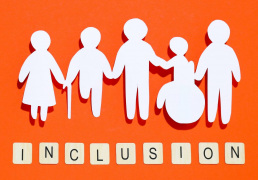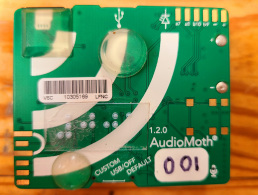Accessibility and Inclusion
In order to make the world of eclipse learning open to as many people as possible, the Eclipse Soundscapes Project is committed to accessibility and inclusion.


Solar eclipses have traditionally been considered a visual phenomenon. For this reason, people who are blind or have low vision (BLV) have often been left out of eclipse learning opportunities. However, there are many ways to experience a solar eclipse using your other senses. You may feel a change in temperature when the Moon blocks the Sun, or hear a change in animal sounds when it suddenly becomes dark in the middle of the day.
The Eclipse Soundscapes Project will encourage participants to learn and observe using all of their senses. While we have put an intentional focus on the inclusion of people who are blind or have low vision, the project is designed to be inclusive of everyone. Rather than design a project for one specific group, we want to encourage people of all abilities to learn alongside one another. We believe science benefits from the inclusion of many people and perspectives!
Here are some of the many ways we try to make our project as accessible and inclusive as possible:
Follow Accessibility Best Practices and Guidance
We follow Web Content Accessibility Guidelines (WCAG), which include things like adding Alt Text to all images on our website or using proper heading structures. This allows people who use screen readers to learn what type of information those images contain and navigate our web pages more easily.
We also make sure that all of our videos use audio description and include Closed Captions or other caption alternatives. The audio description describes all of the content relevant imagery, making it possible to listen to the videos without watching. This can be helpful for anyone in the BLV community, or people who prefer to listen to rather than watch information. The closed captions help people who are deaf or hard of hearing follow the audio content of the video as well as anyone who prefers to watch videos without sound.
Wherever possible, we try to present information in multiple modes. That way, if someone cannot access a particular type of information, they have another way to learn the same information.
These features may be particularly useful to people with certain disabilities, but research shows that presenting information in multiple modes benefits everybody. Check out the article “Why Designing for Accessibility Helps Everyone.”
Make ES Equipment More Accessible


For our Data Collector role, we want to make sure field recording equipment and directions are also accessible.
We selected the AudioMoth recorder for its high-quality, relatively low cost, and open-source development. This not only helps lessen cost barriers, it allows participants to learn about all components of the AudioMoth without an info wall.
With feedback from our accessibility consultants, we added “bump dots” to the AudioMoth to indicate important buttons and ports in a tactile way. We also included training on “How to Make Your AudioMoth More Accessible” and made sure that any corresponding directions included tactile cues.
Offer Different Participant Experiences
The Eclipse Soundscapes Project participant experience is broken down into four different roles. Participants are welcome to participate in all of the roles, but they may choose to participate in just one or two.
That is because certain project activities require different time commitments, access to the location of the eclipse path, and cost of equipment. For example, while the Data Collector Role requires a data collection kit and a location on or near the eclipse path, the Observer Role only requires internet access. We don’t want time, location, or money to prevent anyone from participating in the Eclipse Soundscapes Project, so participants are free to choose the role(s) that work best for them.
We have also tried to keep data collection equipment costs low by choosing relatively affordable recording devices and common household items.
Consider Differences in Language and Literacy
We aim to keep our website and other learning materials readable using plain language, “a style of writing that uses simplified sentences, everyday vocabulary, and clear structure—aims to remove those barriers.” (Reference: What makes writing more readable?)
We’ve also included vocabulary and definitions with our educational lessons. This helps make all of our educational content accessible to most readers. We also include visuals to support participants regardless of their English-language proficiency.
Consult with Focus Groups and Universal Design Professionals
To make a project truly accessible, it is important to consider accessibility and inclusion from the start. Along the way, the Eclipse Soundscapes Project has worked with consultants, focus groups, and universal design professionals to make sure each element of our project is as accessible as possible.
For example, we partnered with the National Federation of the Blind to test the accessibility of our website and our data collection kits for users who are blind and low vision.
We also work with Reginé Gilbert and her students at the NYU Tandon School of Engineering to test and improve various parts of our user interface. Students gain real-world experience incorporating accessibility into their digital design work, and the Eclipse Soundscapes Project improves its user experience to be more accessible and engaging.
Commitment to Solving Challenges
Finding solutions that work for everybody can be challenging! Along the way we have discovered some elements of the Eclipse Soundscapes Project are not as accessible as we’d like them to be. For example, we found that the Open Acoustic Devices website with the time chime button is not accessible. In response, a screen reader accessible time chime button was added to the ES website.
The ES team also determined that there is no way for users who cannot hear the chime sound or see the LED lights to confirm that they have set the time on the Audiomoth data collection device correctly. While we haven’t been able to solve this challenge, we have implemented a safeguard in the event that the AudioMoth’s clock has not been set correctly: The Data Collector online form asks participants to let us know when they deployed the AudioMoth. This way, the ES team can manually assign time to any data we receive without the time set. Ultimately this safeguard will benefit everyone, as not setting the AudioMoth clock correctly could be a challenge for anyone working with an AudioMoth for the first time.
Accessibility and inclusion is an ongoing process. The Eclipse Soundscapes team is dedicated to improving accessibility and inclusion wherever we can. We conduct ongoing accessibility reviews of our website and other materials. If you notice something that can be improved, please reach out to us at outreach@arisalab.org.
